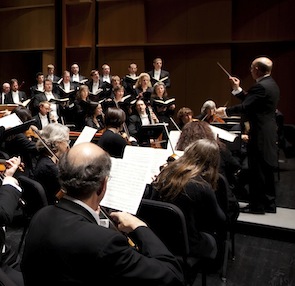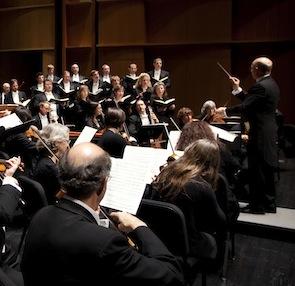
How do you retain the vitality of J.S. Bach’s St. Matthew Passion that made it so revelatory to the parishioners of Leipzig’s St. Thomas Church at its first performance, circa 1727? That’s a question that American Bach Soloists Music Director Jeffrey Thomas contemplated, once he got over his initial wide-eyed excitement at discovering the many differences between the “standard” 1736 autograph score of Bach’s masterpiece and the 2004 edition of Bach’s previously unknown early setting of the work.
As heard in the resonant acoustic of Berkeley’s First Congregational Church, ABS’ performance of the “early version” of St. Matthew’s record of the betrayal and crucifixion of Jesus Christ communicated the Passion with extraordinary beauty and power. With one major exception, Thomas retained Bach’s early thoughts on the work. Hence he used different orchestras for the two choruses, with one central continuo section; reassigned some arias to other singers or instruments; and replaced the chorale/chorus “O Mensch, bewein dein Sünde groß” that ends Part I with the earlier version’s simpler chorus. Most important, he had one-per-part all around for orchestra and voice, with every vocal soloist singing their voice’s corresponding choral part, and reserved the combined forces of the 10 soloists, the 16-voice American Bach Choir, and the Pacific Boychoir for the opening section.
Convinced that the St. Leipzig parishioners would have taken the inclusion of many well-known chorales as a cue to sing along, Thomas also beefed up chorales by having the American Bach Choir join in. The choir’s presence brought to the chorales’ simple, routine tunes an unexpected weight and profundity that complemented the far more sophisticated beauty of Bach’s writing. They served as an unexpected home base, grounding the story before more-intimate forces journeyed deep, then deeper, into the moving tale of Jesus’ final days.
Outstanding Soloists
With a performance this intimate and exposed, the choice of vocal soloists was crucial to emotional impact. As the Evangelist, the narrator whom we hear the most, tenor Wesley Rogers sang flawlessly. Although he lacked the simple purity that Thomas himself brought to the part in ABS’ 1996 recording of the work, and had a tendency to sound uncharacteristically fierce in First Congo’s acoustic when he opened up his voice higher in the range, his technical surety and vocal beauty made a substantial mark.
For his ability to infuse his voice with refined yet palpable pathos, baritone Joshua Copeland created a deeply moving Jesus.
For his ability to infuse his voice with refined yet palpable pathos, baritone Joshua Copeland created a deeply moving Jesus. The restrained dignity of his consistently lyrical voice, which could serve as a role model for singing “authentically” with feeling, contrasted tellingly with the blunter, almost dumb-jockish sound of Robert Stafford’s betraying Judas in Chorus II. (Thomas would deserve a typecasting Oscar if a Baroque Academy Awards ceremony were held.)
Among the men, Chorus I bass Mischa Bouvier’s immensely sympathetic, soulful voice lent uncommon depth to the aria “Komm, süßes Kreuz, so will ich sagen” as well as to everything else he sang. It’s easy to see why this presumably young artist won awards in four competitions in 2009–2010; his rare vocal and interpretive gifts all but ensure many major solo turns in the years ahead. May he and Copeland return frequently, and not just in Baroque music.
Also outstanding, albeit soloing less frequently than Bouvier, was Chorus II tenor Derek Chester, with a lighter, more idiomatically “Evangelist” sound. His recitative and aria, “Mein Jesus schweigt … Geduld!,” exquisitely accompanied by oboists Debra Nagy and Stephen Bard, and by continuo players William Skeen (cello), Steven Lehning (violone), and Corey Jamason (organ), was a high point. Chorus II countertenor Jay Carter seemed underpowered and spotty at first, yet he came into his own with increased volume and an emotionally evocative leading edge to the voice in his beautiful recitative and aria, “Erbarm es Gott! ... Können Tränen meiner Wangen.”
Every instrumentalist was, in effect, a superb soloist.
Among the women, Chorus I soprano Clara Rottsolk stood out for her power, dignity, and immensely sympathetic contributions. As soon as she brought beautiful, gleaming tone to her first recitative and aria, “Wiewohl mein Herz … Ich will dir mein Herze schenken” (which translates to “My heart swims in tears … I want to give you my heart”), I sank into hers, as well.
Chorus I alto Danielle Reutter-Harrah, currently pursuing her master’s at San Francisco Conservatory of Music, is still developing as an artist. Her promise was at times fulfilled with beauty and passion. Chorus II soprano Anne-Kathryn Olsen has a lighter, almost soubrettish voice that brought to her solo a naive quality absent from other performances. Chorus I tenor Aaron Sheehan initially sounded pushed on top when paired with Chorus II in the recitative “O Schmerz!,” but flowered in their aria, “Ich will bei meinem Jesu wachen.”
In reviewing a performance in which every instrumentalist was, in effect, a superb soloist, there’s not room to mention every player. But, in addition to those already singled out, I’d be remiss not to applaud the two orchestras’ first violinists, Tekla Cunningham and Elizabeth Blumenstock, as well as Thomas himself on Lautenwerk.
St. Matthew Passion is a long work whose subject matter does not necessarily carry the same appeal and emotional sway as it did to believers close to 300 years ago. Yet, when cleansed of much historical baggage, it shone as new. Thanks to Thomas and ABS for such a profoundly beautiful, moving evening.

